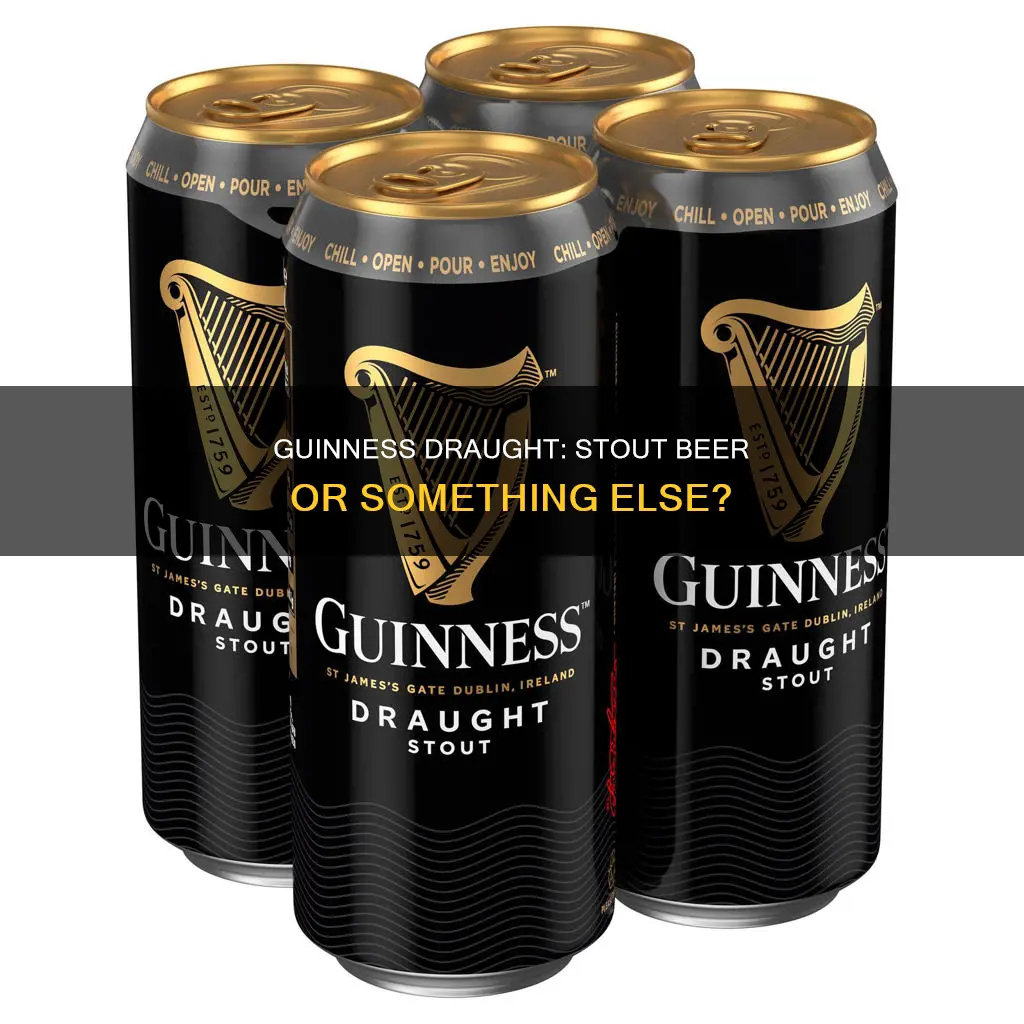
Guinness Draught is a popular stout beer with a distinct appearance and flavour. Its dark ruby red colour and creamy head give it a unique look, while its smooth, bitter-sweet taste with hints of roasted coffee and chocolate has made it a favourite among beer enthusiasts. First brewed in 1959 to celebrate the 200th anniversary of Arthur Guinness signing a lease on St. James's Gate Brewery, Guinness Draught has since become an iconic Irish stout, known for its perfectly balanced flavour and creamy mouthfeel.
| Characteristics | Values |
|---|---|
| Colour | Dark Ruby Red |
| Taste | Sweet, Bitter, Roasted, Coffee, Chocolate |
| ABV | 4.2% |
| Calories | 125-126 per 12-ounce serving |
| Carbohydrates | 10 grams per 12-ounce serving |
| Protein | 1 gram per 12-ounce serving |
| Fat | 0 grams per 12-ounce serving |
What You'll Learn

The history of Guinness Draught
Guinness has a long and storied history that began in 1759 when Arthur Guinness signed a 9,000-year lease on St. James's Gate Brewery in Dublin, Ireland. At the time, Guinness brewed a variety of ales and beers, but in 1799, the company decided to focus exclusively on porter, a dark beer with a rich head. This decision proved to be a turning point for the company, as the beer, later known as stout, became immensely popular and came to be regarded as the national beer of Ireland.
In the early 1800s, Arthur Guinness II, the son of Arthur Guinness, introduced the West Indies Porter, which was later renamed Foreign Extra Stout. This beer became the longest continually brewed recipe in the history of Guinness and helped establish the company as a global brand. In 1821, Arthur Guinness II released another iconic beer, the Extra Stout, which is still popular around the world today.
Guinness became Ireland's largest brewery in 1838 and continued to expand, becoming the world's largest brewery by 1886, producing 1.2 million barrels annually. The company remained a family business for five generations before changes in ownership occurred in the last half-century. Today, Guinness is owned by Diageo, a British multinational beverage company.
One of the most significant innovations in the history of Guinness came in 1959 with the introduction of nitrogenated beer. Michael Ash, a scientist and mathematician, developed a special keg, known as the Ash Can, that recreated the two-part pour of blending a fresh cask of beer with an aged cask, which was previously done by bartenders. This innovation resulted in a creamier and smoother drink, becoming a hallmark of Guinness Draught Stout.
In 1965, Guinness Draught Stout was released in the United States, and it quickly gained a cult-like following due to its unique two-part pouring ritual and distinct appearance. The use of nitrogen in the brewing process created smaller bubbles, giving the beer a creamier and smoother texture compared to traditional carbonation.
Guinness has left an indelible mark on popular culture, with its beers featured in books and movies, and it has become synonymous with Ireland and its rich history and culture. The company has faced some controversies, including a corporate scandal in the 1980s, but it has also been recognised for its philanthropic efforts and commitment to employee welfare.
Today, Guinness is the largest brewer of stout in the world, with a significant presence in Africa and a dedicated fan base that collects memorabilia and travels the world to taste Guinness at its source. The brand continues to evolve, introducing new variations and making their beers suitable for vegetarian and vegan consumers.
Guinness Beer and Keto: Is It a Match?
You may want to see also

Guinness Draught's flavour profile
Guinness Draught is an Irish dry stout with a flavour profile that is both bitter and sweet. It has a creamy, thick head, a light body, and a low ABV of 4.2%. Its flavour is often likened to coffee and dark chocolate, with a hint of vanilla, and a malty, slightly sweet, roasty taste. The bitterness comes from the hops and the citric quality of roasted barley.
The unique flavour of Guinness Draught is created by a combination of ingredients and brewing techniques. The beer is made from roasted barley, malted barley, hops, yeast, and water. The use of nitrogen rather than carbon dioxide gives it a creamy head and a velvety mouthfeel. The small, tightly packed bubbles created by the nitrogen softly carbonate the beer, resulting in a smooth and light-bodied drink.
The process of roasting the barley imparts toasty, caramelized flavours with a touch of acidity and vanilla notes. The malted barley lends sweetness, which balances the roasted quality and creates a distinctive chocolate flavour. The combination of hops and the citric quality of roasted barley adds a balanced bitterness.
The aroma of Guinness Draught is mild coffee and toasty malt, with nutty and slightly saline hints. The roasted barley is more prominent on the palate, giving the beer its distinctive dark ruby red hue. The nitro pour, created by the use of nitrogen, gives the head a smoother appearance with tighter bubbles than if carbon dioxide had been used. This results in a creamy, long-lasting head that provides additional bittersweet flavour.
Guinness Draught is best served cold, chilled to 46.4°F (8°C) for at least 24 hours before serving. When pouring, the glass should be tilted at a 45-degree angle and filled to three-quarters before allowing the surge to settle. The glass is then filled to the top, resulting in a perfectly balanced pint.
The Brewing Process: Guinness Beer Filtration Techniques
You may want to see also

How to pour the perfect pint
Guinness Draught is indeed a stout beer. It is an Irish dry stout, to be precise, and is one of the world's great pub beers.
Now, to pour the perfect pint of Guinness, follow these steps:
Step 1: Glassware
Select the right glass, preferably a clean, dry, and cool Guinness tulip glass, also known as a Gravity Glass. The glass should be tilted at a 45-degree angle to the tap.
Step 2: The Initial Pour
Hold the glass steadily and confidently. Aim the tap nozzle at the gold harp logo on the glass. Pour until the beer reaches the top of the harp, then stop. The glass should now be about half-full.
Step 3: Settling
This is the 'surge and settle' phase. Set the glass down and let the beer rest. You'll witness the magic of Guinness as the darker stout slowly sinks beneath the creamy, white foam. This step usually takes around 60-90 seconds.
Step 4: Topping Off
Once the beer has settled, fill up the glass completely. This time, keep the glass straight. The foam should form a slight dome over the top, creating the iconic Guinness head.
Step 5: Presentation
Present the pint with pride and a touch of Irish charm. The Guinness logo on the glass should face the drinker, inviting them to savour every sip.
Common Mistakes to Avoid:
- Pouring too quickly or not allowing enough settling time.
- Underfilling or overfilling the glass.
- Incorrect temperature—Guinness should be served cold, ideally at 38°F (3-8°C).
- Dirty glassware or draught system components can disrupt the pour and affect the taste.
Remember, pouring the perfect pint of Guinness is an art form, a blend of precision and patience. It's a ritual that enhances the drinking experience, transforming a simple pint into a symphony of flavour, texture, and tradition.
Guinness Beer: A Source of Vitamins?
You may want to see also

Guinness Draught's calorie count
Guinness is a popular Irish beer that is famous for its dark, creamy, and foamy appearance. Interestingly, a pint of Guinness contains fewer calories than most beers, with only 210 calories. This is surprising, as many people associate the dark colour and creamy texture with a high calorie content. However, the distinct appearance of Guinness is a result of the roasting process and the addition of nitrogen, rather than a high calorie count.
A standard 12-ounce (355 ml) serving of Guinness Original Stout provides approximately 125 calories. The calorie content can vary depending on the specific type of Guinness and its alcohol content. For example, a 14.9-ounce can of Guinness Draught contains 155 calories, while a 16-ounce serving contains 170 calories.
The calorie contribution from alcohol is significant, as each gram of alcohol contains seven calories. The good news is that Guinness has a relatively low alcohol content, ranging from four to six percent. This results in a lower calorie count compared to other beers.
In addition to its low-calorie content, Guinness also offers some nutritional benefits. It is a good source of iron, providing almost 4% of the daily recommended intake in a 12-ounce serving. Guinness also contains antioxidants, vitamins, and minerals, including vitamin B6 and niacin, which are important for overall health and well-being.
So, if you're looking for a indulgent yet relatively low-calorie beer, Guinness is a great option. Just remember to always drink in moderation and enjoy it as part of a balanced lifestyle.
The Irish Pride: Guinness Beer's Roots and Heritage
You may want to see also

Cooking with Guinness Draught
Guinness Draught is a stout beer that is a popular drink, especially on St. Patrick's Day. However, it can also be used as an ingredient in cooking, adding a rich, roasted wheat flavour to both sweet and savoury dishes.
Savoury Dishes
Guinness is a great addition to many savoury dishes, especially those with robust flavours. It is a popular ingredient in Irish dishes, such as the classic beef and Guinness pie, a well-balanced meal encased in homemade pastry. The beer is also commonly used in marinades, pairing well with garlic, onion, shallot, Dijon mustard, and fresh herbs. This can be used on a range of meats and vegetables, enhancing their flavour.
Guinness is also a great addition to cheese-based dishes, such as cheese dips, fondue, and beer cheese soup. It can be used to make beer bread, such as the popular bacon cheddar beer bread, or cheesy Guinness bread. For a hearty meal, try a Guinness beef stew with cheddar herb dumplings, or a mushroom and sweet potato pot pie.
Sweet Dishes
When it comes to desserts, Guinness is a perfect pairing for chocolate. It intensifies the chocolate flavour and makes for indulgent treats like brownies, chocolate cake, and chocolate-glazed donut holes. Try a chocolate Guinness Bundt cake with whiskey whipped cream, or some Guinness chocolate cupcakes with Baileys buttercream.
For a refreshing treat, make some boozy Guinness ice cream floats, or try the unique Guinness and chocolate cheesecake. If you're feeling creative, experiment with Guinness Snickerdoodles, adding a sweet and slightly bitter flavour to the classic cinnamon and sugar cookies.
So, whether it's a savoury dish or a sweet treat, Guinness Draught can be a versatile ingredient in your kitchen, adding a unique flavour to your creations.
Guinness Beer's pH Mystery: Acidic or Not?
You may want to see also
Frequently asked questions
Yes, Guinness Draught is a stout beer. It is also referred to as a dry stout or Irish stout.
Guinness Draught has a light and smooth taste with notes of roasted barley, caramel, coffee and chocolate. It is creamy, bitter-sweet, and well-balanced.
Guinness Draught has an ABV of 4.2%, which is lower than many other stouts.
Guinness Draught is best served using the famous "two-part" pour. First, pour the beer into a clean, dry glass tilted at 45 degrees until it is three-quarters full. Allow the surge to settle before filling the glass completely.
Guinness Draught has approximately 125-126 calories per 12-ounce serving, which is similar to light beers.







